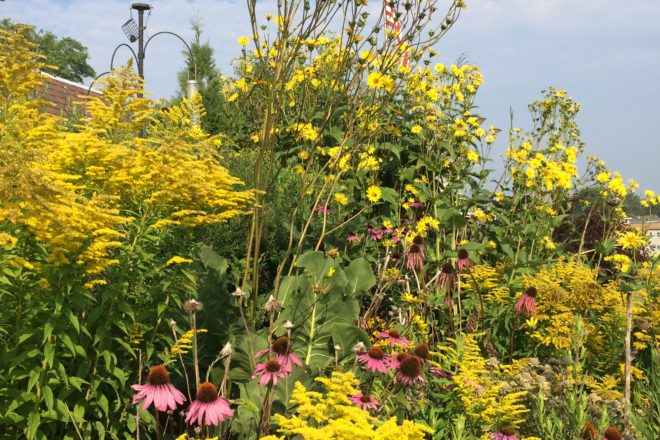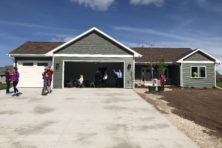Algoma’s Bird Bistro Program Aims to Build Bird-friendly Community
- Share
- Tweet
- Pin
- Share

Five years ago, a volunteer group of seven bird-loving residents of Algoma came together in pursuit of helping their city achieve Bird City Wisconsin status, recognizing communities that enhance bird habitats through landscaping and public education.
In 2013, the city achieved that designation and in the years since, the committee has continued hosting and developing educational programs on the important role birds play in the environment.
One such program, in its fourth year, is the Algoma Bird Bistros movement. The goal of the movement is to encourage homeowners, businesses, city government and other landowners to landscape for the benefit of birds by providing three basics: food, water and shelter.
Participation is open to everyone, and the Bird City Algoma Committee will recognize Bird Bistros with a special garden ornament. There are four basic requirements for an area to be considered a Bird Bistro:
- at least 5’ x 5’
- five or more kinds of native plants
- free of pesticide and herbicide use
- no free-roaming cats
To set these parameters, the committee relied on the expertise of professionals such as State of Wisconsin avian ecologist Kim Grveles and Doug Tallamy, chair of the department of entomology and wildlife ecology at the University of Delaware. Mary Goodner, a founding member of the Bird City Algoma Committee, pointed to Tallamy’s book Bringing Nature Home: How You Can Sustain Wildlife with Native Plants as a good starting point for those interested in landscaping for the benefit of birds, particularly as it relates to native plants.

The beginning of Dale and Mary Goodner’s bird-feeding station in Algoma, 2010. Submitted.
“In research, he [Doug Tallamy] found out that 95 percent of birds rely on caterpillars and insects to feed their chicks in order to get the chicks off the nest,” Goodner said. “You can have a bird feeder up and the birds will take seeds at other times of year but when those nestlings are on the nest, the nestlings need the protein of caterpillars and insects otherwise they’re not going to be able to make it. In order to get caterpillars and insects into your yard, they are very specific and they just can’t chew up any kind of tissues from any kind of plants. Because of the enzymes in their body they need the plants that they grew up with. They need the native plants of the area.”
Native plants, Goodner explained, are those that existed in an area prior to the European settlement. The work of the Bird City Algoma Committee has become particularly important as homeowners continue planting non-native plants in their yards. By educating the public on the benefits of native plants, Goodner hopes the public’s interest and use of native plants will encourage more landscaping companies to supply them.
In educating the public, state avian ecologist Kim Grveles relies on The Nature Conservancy’s three categorizations of migratory bird stopover sites, which relate particularly to forest-dependent songbirds. The categories draw parallels to human life to better illustrate the benefits and limitations of each. They are:
- fire escape
- convenience store
- full-service hotel
A “fire escape” habitat is infrequently used but vital to birds, and applies to something like a row of shrubs along a parking area in an urban setting or to a small wooded lot surrounded by large, open farm fields in a rural setting. It provides a temporary resting and/or cover spot for birds to survive inclement weather or escape predators.
A convenience store, similar to human life, is used occasionally or regularly and provides limited resources. An example would be a county park or even a small state park.
“They’ll be able to stay a little longer at a convenience store – it’s one-stop shopping,” Grveles said. “We might stop at a convenience store and we may not find exactly what we want but we’ll get something that will tie us over to the next stop and the same is true for birds at a convenience store stopover. They will find a little something to eat, they’ll get some rest and at some point not very long after they arrive they will have to move on to find more resources for refueling.”
The most resources will be found at a “full-service hotel” stopover with high quality food and shelter, like Peninsula State Park.
“What they’re going to need in the way of a full-service hotel is a large block of contiguous forest that has a mosaic of different habitat types so they have lots of choices and they can keep moving from one habitat to another without having to fly across open water or fly across an open farm field or try to navigate through a city, urban situation,” Grveles said.
Outside of actual habitat and food sources, there are a few other extra credit items the Bird City Algoma Committee will recognize:
- adding Dutch white clover to existing lawn
- providing brush piles for bird shelter
- mulching around trees
- leaving leaf litter for ground feeding birds
- providing water
- adding nest boxes or providing nesting material
- making windows bird-safe
The last one on the list is one of the most important.
“If we’re going to attract them to our yard by planting native plants and putting out bird feeders and all the things that people like to do to bring birds to their yard, then we have an obligation to keep them safe from crashing into those windows,” Grveles said.

Goldfinch. Photo by Dale Goodner.
A good resource for preventing collisions and other issues is the American Bird Conservancy website, abcbirds.org. By eliminating threats to the bird population and providing food and habitat resources in these important stopover locations, residents will ensure good reproductive success when birds arrive in their breeding areas. That, Grveles said, is a win-win situation.
“The advantage is if you plant native trees and shrubs, they will come to your yard and grace your yard with their beauty and their songs, and you get to enjoy them,” she said. “It’s like one of the trees…if we do something to help them, they will reward us by showing up.”
Mary Goodner and Cathy Pabich, of the Bird City Algoma Committee, will lead a native plant gardening program at 5pm on Tuesday, June 13 at the Algoma Public Library, 406 Fremont St. in Algoma. They will do a Bird Bistro presentation with Kim Grveles at 4:30pm on Saturday, Sept. 9 at The Ridges Sanctuary, 8166 Highway 57 in Baileys Harbor. For more on Bird Bistros, contact Goodner at [email protected] or Pabich at [email protected].

